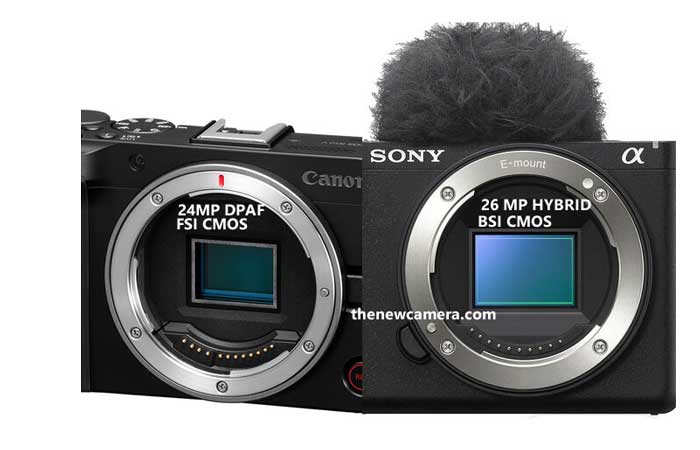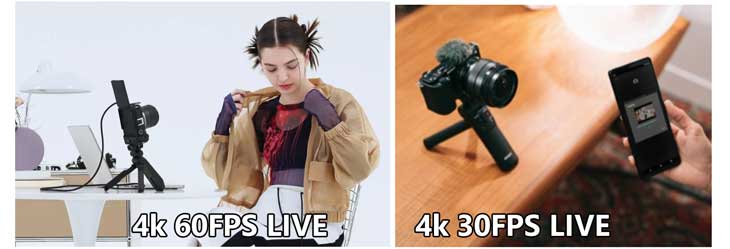Canon R50V, we are Sony Z10 Mark II. Let’s discuss the major differences between the two, then we will do some deep core specification analysis so you can understand very clearly which camera you should buy.
Canon R50 V Specifications and Pricing
Initially, the Canon R50 V camera is available with a 24-megapixel DPAF CMOS sensor, the same sensor that is being used by entry-level cameras such as Canon R50 and Canon R10. If you buy it with a kit lens, you have to pay approximately $849, and when you are buying the body only, you have to pay approximately $649.
Sony Z10 Mark II Specifications and Pricing
Now, the Sony Z10 Mark II camera was released on July 10, 2024, and uses a 26-megapixel APS-C BSI CMOS sensor from FX30 or Sony A6700 camera, meaning it’s a flagship sensor. With a kit lens, you have to pay $1,099, and without a kit lens, you have to pay only $999.
So, the Canon body is a lot more affordable compared to the Sony Z10 Mark II camera. Now, let’s dive deep into the detailed core specifications of both cameras.

Key Differences in Sensor Technologies
So, initially, we have some basic differences between the two. The Canon uses an FSI CMOS sensor with a resolution from entry-level models, and the Sony Z10 Mark II uses a BSI CMOS sensor from higher-end models. Along with that, we also have a price difference between the two.
Best Camera for Recording 4K 60p Video

Crop Factor Comparison
If you compare both the Canon R50 V and Sony ZV-E10 Mark II, the advantage of the Sony ZV-E10 Mark II camera is clearly visible as it does only a 1.1x crop while recording 4K 60p video. On the other side, we have the Canon R50 V camera, which does a 1.5x crop while recording 4K 60p video. Both cameras allow you to record 10-bit videos at 4K 60p, but at the same time, you have to face a crop in Canon.
Usability and Stabilization
Usability-wise, the Sony ZV-E10 Mark II camera is more usable since, even while recording 4K 60fps with a crop, we can utilize the Active SteadyShot mode as well as the gyro-based image stabilization mode. If you are shooting handheld videos, that will, in turn, help you get stable footage without a gimbal. The electronic image stabilization (EIS) is very effective when you are using it at 30fps or 24fps recording. However, since it already has a very significant 1.5x crop, it doesn’t work that well.
Final Recommendation for high-speed 4k videos
So, overall, for 4K 60fps recording, we highly recommend you to get the Sony ZV-E10 Mark II camera. Codec and Color Depth in Both Cameras
Video Codecs
Canon R50 V Video Capabilities
Now, with a 24-megapixel FSI CMOS sensor, our recently announced Canon R50 V camera is able to record 10-bit 4:2:2 videos in H.265 or H.264 codec. You can also record your videos in Canon Log 3 as well as in HLG HDR modes—all these features are available in this entry-level model.
Sony Z10 Mark II Video Capabilities
With a 26-megapixel BSI CMOS sensor, Sony does the same. It also records 10-bit 4:2:2 videos in XAVC HS (H.265) and XAVC S (H.264). Additionally, it supports S-Log2, S-Log3, and Hybrid Log Gamma (HLG), offering up to 14 stops of dynamic range.
Comparison and Conclusion
So, in terms of video codec, both cameras record the same 10-bit videos, and neither of them has any limitations over log profiles or any other video codec restrictions. In terms of usability for beginners, videographers, and content creators, both cameras perform well. We are not discussing professional use at this moment.

Best Camera for Live Streaming
Canon R50 V Live Streaming Capabilities
The recently announced Canon R50 V supports streaming up to 4K 60fps via USB-C, but at the same time, you have to consider the fact that it still has a 1.5x crop. This means you need to use ultra-wide-angle lenses when placing the camera in front of you.
Sony ZV-E10 Mark II Live Streaming Capabilities
On the other hand, in the Sony ZV-E10 Mark II, video streaming or USB streaming remains limited to 4K 30fps via UVC/USC.
Comparison and Conclusion
So, you can consider the Canon R50 V as a clear winner in terms of streaming capability, but it also suffers from a crop limitation, which you need to keep in mind while choosing between these two cameras.
Canon R50V Autofocus Capabilities
Canon R50V camera uses Dual Pixel CMOS autofocus sensor paired with DIGIC X image processor, and according to Canon’s official press release, they are using the same autofocus AF algorithm as they have used in the Canon R5 Mark II camera. The camera also includes subject tracking modes, which include birds, animals, airplanes, moving vehicles, as well as one of the most important modes that has been added to this camera—face registration. Here, you can technically register one, two, or multiple faces, and even in a crowd when you are creating a video sequence, like when you’re doing wedding cinematography. Then, even in a crowd, if you have already registered the bride and groom’s faces in the camera, it will track only those two.
Sony ZV-E10 Mark II Autofocus Capabilities
Now, in the Sony ZV-E10 Mark II camera, we have an advanced video autofocus tracking mode, which is directly coming from the Sony A7R V. It does have predictive AI tracking, just as we have seen in higher-end Sony models, so it is also very good at predicting human faces, human bodies, animals, birds, and eyes. Moreover, the camera also has a built-in AI auto-framing mode, which, in turn, Canon R50 V doesn’t have. This particular AI auto-framing mode helps content creators, especially solo content creators—those who create cooking videos in a single room. The camera will automatically track them and crop them in a frame like the way a professional cinematographer is shooting their movement.
Best Camera with Usable AF
So, each of these cameras does have brilliant autofocus tracking capability and some specialized modes. The Canon R50 V is more suitable for wedding cinematography, where you can register people’s faces for autofocus tracking, whereas in the Sony ZV-E10 Mark II camera, we have AI auto-framing mode, which is more useful for content creators.
Canon R50 V Image Stabilization
Canon R50 V camera is a base model, and we are not able to expect too much out of it. Since the absence of sensor-shift image stabilization looks a bit logical to me, any camera maker out there is not offering any sort of IBIS mechanism in that price range. Although the camera does have EIS (Electronic Image Stabilization), which is effective for video, you have to use ultra-wide-angle lenses when you are using EIS in the camera for creating content or shooting any sort of videos. But keep in mind that EIS is only effective in shooting videos, not in still photography.
Sony ZV-E10 Mark II Image Stabilization
Sony ZV-E10 Mark II camera comes at a higher price, and at least we were expecting the presence of some sort of IBIS feature inside it. But for video recording purposes, we do get Active I.S. inside this camera, supported with a gyro-based image stabilization system. So, specifically, when you are using gyro, you get very stable footage with minimal crop, but you have to post-process it on your laptop or PC using Sony Catalyst Browse software. Other than that, we have Active I.S. mode, where Sony does crop significantly, but we do get gimbal-like stable footage from the camera.
Final Comparison
So overall, none of the cameras feature sensor-shift image stabilization systems, but in the Sony ZV-E10 Mark II camera, we do have gyro-based image stabilization as well as Active Mode, which is very effective. Price-wise, what we are getting in Canon R50 V also looks very logical to me, specifically if you are into content creation. So, it’s very obvious that if you are paying a bit higher price for a camera body like the Sony ZV-E10 Mark II, you will get better image stabilization performance, which is specifically made for videographers and cinematographers.
Body Design & Battery Life
Body design-wise, both cameras are the same, and even the weight is almost equal, at under 400 grams. However, in the Sony ZV-E10 Mark II camera, we get a deeper hand grip as well as a battery life similar to that of a full-frame camera. The NP-FZ100 battery is capable of giving you approximately 610 shots and more than 2 hours of continuous 4K 30p video recording.
In contrast, the Canon R50 V camera uses the regular LP-E17 battery, which offers approximately 230 shots and around 1 hour and 20 minutes of 4K 30p video recording.
Still Photography & Sensor Comparison
For still photography, the Canon R50 V camera uses a 24-megapixel FSI CMOS sensor and supports up to 12 FPS with an Electronic First Curtain Shutter (EFCS) and approximately 15 FPS with an electronic shutter.
Whereas in the Sony ZV-E10 Mark II camera, we have a 26MP BSI CMOS sensor with a maximum continuous shooting speed of 11 FPS, limited to an electronic shutter only. Technically, having an EFCS sensor-based camera is a better option if you’re planning to shoot sports or wildlife photography.
As we all know, Canon’s 100-400mm lens is also available at a budget-friendly price, making it a great pair for those into sports and wildlife photography, as well as content creation. However, at the same time, we must consider the advantage of a 26MP BSI CMOS sensor.
Final Decision
If you are not into sports and wildlife photography and are looking for higher detail, better low-light performance, and enhanced dynamic range, then getting a 26MP sensor will be a better decision.
Final Conclusion: Which Camera is Best for You—Canon R50 V or Sony ZV-E10 Mark II?
Tailored for Videographers & Content Creators
Both of them are custom-tailored for videographers or content creators, and the best part is Canon is offering us a 10-bit video recording mode in a budget body. But at the same time, we do have some limitations, like having a 1.5x crop in 4K 60 FPS mode. Other than that, we also have limitations in the Canon RF mount, which actually limits us in selecting budget lenses.
Canon Lens Availability & Limitations
So even if you have purchased a budget body from Canon, then it will be a bit hard to find a usable prime lens within budget. Specifically, if you have purchased the Sony ZV-E10 Mark II camera by paying a bit higher price, you can use lenses like Viltrox Air series, which come at a very low price with usable high-grade optics.
Choosing Based on Personal Requirement
But again, it all depends upon your own personal requirement and usage. If you have already sorted out the best lenses that you are going to use for the Canon R50 V camera and having a crop in 4K 60 FPS mode doesn’t bother you, then without a doubt, the R50 V is much more usable for you.
Advantages of Sony ZV-E10 Mark II
Similarly, in the Sony ZV-E10 Mark II camera, we are getting uncropped 4K 60 FPS mode, we are getting active image stabilization as well as AI autofocus and ZV-E10’s in-body stabilization, plus some extra features and extra battery life in the Sony camera. The most important factor is the range of lenses available for the ZV-E10 Mark II.
Final Verdict
So for me, the best budget camera is the Canon R50 V, but if you consider lens availability, then you have to spend a lot more to get perfect Canon lenses for your camera.
